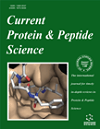- Home
- A-Z Publications
- Current Protein and Peptide Science
- Previous Issues
- Volume 20, Issue 9, 2019
Current Protein and Peptide Science - Volume 20, Issue 9, 2019
Volume 20, Issue 9, 2019
-
-
Protein Engineering for Improved Health: Technological Perspectives
More LessAuthors: Mandeep, Rajeshwari Sinha and Pratyoosh ShuklaProtein engineering has enabled development of novel proteins aimed at disease diagnosis, alleviation and improved health attributes. The present article provides an overview of recent approaches and techniques used to modify proteins at diverse levels, which find therapeutically relevant applications. There is immense interest among researchers to discover new and increasingly valuable solutions for various health relate Read More
-
-
-
On the Measurement of Cooperativity and the Physico-Chemical Meaning of the Hill Coefficient
More LessAuthors: Andrea Bellelli and Emanuele CagliotiCooperative ligand binding is a fundamental property of many biological macromolecules, notably transport proteins, hormone receptors, and enzymes. Positive homotropic cooperativity, the form of cooperativity that has greatest physiological relevance, causes the ligand affinity to increase as ligation proceeds, thus increasing the steepness of the ligand-binding isotherm. The measurement of the extent of cooperati Read More
-
-
-
ATP-Diphosphohydrolases in Parasites: Localization, Functions and Recent Developments in Drug Discovery
More LessATP-diphosphohydrolases (EC 3.6.1.5), also known as ATPDases, NTPases, NTPDases, EATPases or apyrases, are enzymes that hydrolyze a variety of nucleoside tri- and diphosphates to their respective nucleosides, being their activities dependent on the presence of divalent cations, such as calcium and magnesium. Recently, ATP-diphosphohydrolases were identified on the surface of several parasites, such as Trypanosoma s Read More
-
-
-
Cationic Antimicrobial Peptides for Tuberculosis: A Mini-Review
More LessAuthors: Sara Silva and Nuno ValeCationic antimicrobial peptides (CAMPs) can be considered as new potential therapeutic agents for Tuberculosis treatment with a specific amino acid sequence. New studies can be developed in the future to improve the pharmacological properties of CAMPs and also understand possible resistance mechanisms. This review discusses the principal properties of natural and/or synthetic CAMPs, and how these new peptides h Read More
-
-
-
Methodologies and Applications of Proteomics for Study of Yeast Strains: An Update
More LessYeasts are one of the mostly used microorganisms as models in several studies. A wide range of applications in different processes can be attributed to their intrinsic characteristics. They are eukaryotes and therefore valuable expression hosts that require elaborate post-translational modifications. Their arsenal of proteins has become a valuable biochemical tool for the catalysis of several reactions of great value to th Read More
-
-
-
Glutathione, an Antioxidant Tripeptide: Dual Roles in Carcinogenesis and Chemoprevention
More LessAuthors: Arunaksharan Narayanankutty, Joice T. Job and Vinayak NarayanankuttyGlutathione (GSH or reduced glutathione) is a tripeptide of gamma-Glutamyl-cysteinylglycine and the predominant intracellular antioxidant in many organisms including humans. GSH and associated enzymes are controlled by a transcription factor-nuclear factor-2 related erythroid factor-2 (Nrf2). In cellular milieu, GSH protects the cells essentially against a wide variety of free radicals including reactive oxygen species, lipid Read More
-
-
-
Regulatory Roles of GADD45α in Skeletal Muscle and Adipocyte
More LessAuthors: Wenjing You, Ziye Xu and Tizhong ShanGADD45α, a member of the GADD45 family proteins, is involved in various cellular processes including the maintenance of genomic integrity, growth arrest, apoptosis, senescence, and signal transduction. In skeletal muscle, GADD45α plays an important role in regulating mitochondrial biogenesis and muscle atrophy. In adipocytes, GADD45α regulates preadipocyte differentiation, lipid accumulation, and thermogenesis Read More
-
-
-
Roles of E6 and E7 Human Papillomavirus Proteins in Molecular Pathogenesis of Cervical Cancer
More LessHuman papillomavirus (HPV) cancers are expected to be major global health concerns in the upcoming decades. The growth of HPV-positive cancer cells depends on the consistent expression of oncoprotein which has been poorly taken into account in the cellular communication. Among them, E6/E7 oncoproteins are attractive therapeutic targets as their inhibition rapidly leads to the onset of aging in HPV-positive cancer cells. T Read More
-
-
-
Endoplasmic Reticulum Stress Signaling Pathways: Activation and Diseases
More LessAuthors: Zhi Zheng, Yuxi Shang, Jiahui Tao, Jun Zhang and Bingdong ShaSecretory and membrane proteins are folded in the endoplasmic reticulum (ER) prior to their exit. When ER function is disturbed by exogenous and endogenous factors, such as heat shock, ultraviolet radiation, hypoxia, or hypoglycemia, the misfolded proteins may accumulate, promoting ER stress. To rescue this unfavorable situation, the unfolded protein response is activated to reduce misfolded proteins within the ER. Upon Read More
-
-
-
Human Amylin: From Pathology to Physiology and Pharmacology
More LessAuthors: Wei Ling, Yan-Mei Huang, Yong-Chao Qiao, Xiao-Xi Zhang and Hai-Lu ZhaoThe histopathological hallmark of type 2 diabetes is islet amyloid implicated in the developing treatment options. The major component of human islet amyloid is 37 amino acid peptide known as amylin or islet amyloid polypeptide (IAPP). Amylin is an important hormone that is co-localized, copackaged, and co-secreted with insulin from islet β cells. Physiologically, amylin regulates glucose homeostasis by inhibiting insulin an Read More
-
Volumes & issues
-
Volume 26 (2025)
-
Volume 25 (2024)
-
Volume 24 (2023)
-
Volume 23 (2022)
-
Volume 22 (2021)
-
Volume 21 (2020)
-
Volume 20 (2019)
-
Volume 19 (2018)
-
Volume 18 (2017)
-
Volume 17 (2016)
-
Volume 16 (2015)
-
Volume 15 (2014)
-
Volume 14 (2013)
-
Volume 13 (2012)
-
Volume 12 (2011)
-
Volume 11 (2010)
-
Volume 10 (2009)
-
Volume 9 (2008)
-
Volume 8 (2007)
-
Volume 7 (2006)
-
Volume 6 (2005)
-
Volume 5 (2004)
-
Volume 4 (2003)
-
Volume 3 (2002)
-
Volume 2 (2001)
-
Volume 1 (2000)
Most Read This Month
Article
content/journals/cpps
Journal
10
5
false
en


